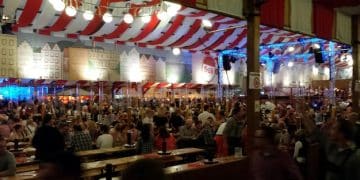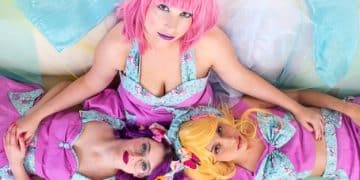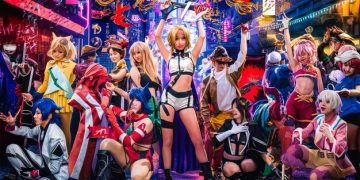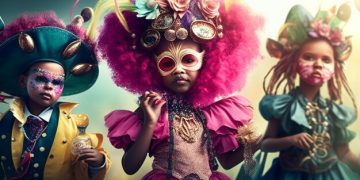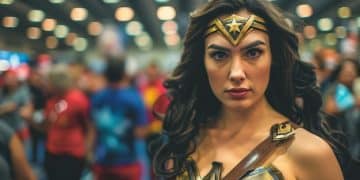The Ultimate Guide to Cosplay: Transforming into Your Favorite Characters
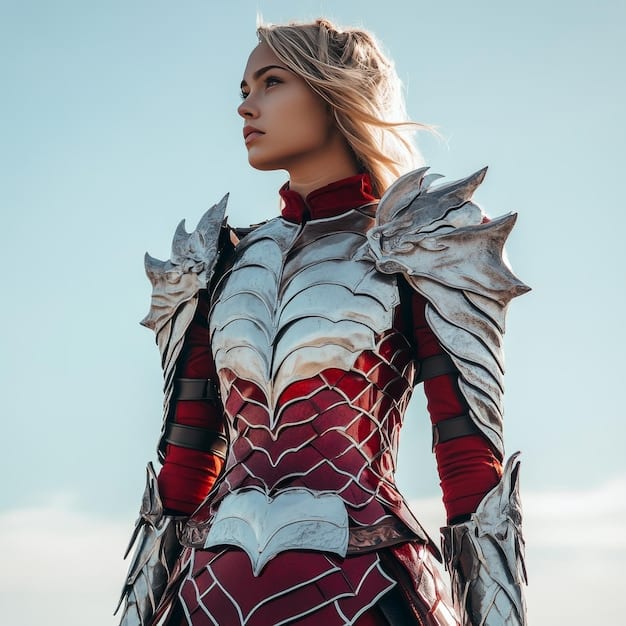
Cosplay, a blend of “costume” and “play,” is an immersive art form where enthusiasts transform into characters from anime, manga, video games, comics, and more, through detailed costumes, makeup, and performance.
Dive into the vibrant world of cosplay, where imagination meets craftsmanship. More than just dressing up, cosplay is a celebration of fandom, a platform for creativity, and a community bound by shared passion. Ready to bring your favorite character to life?
What is Cosplay? A Deep Dive into the Art of Transformation
Cosplay, short for “costume play,” is more than just dressing up. It’s a performance art where individuals embody characters from various forms of media, including but not limited to anime, manga, video games, comic books, and movies. It’s a celebration of fandom and a creative outlet for individuals to express their passion.
The essence of cosplay lies in the transformation process. Cosplayers meticulously craft or commission costumes, paying attention to the smallest details. They also adopt the mannerisms, poses, and even the personalities of the characters they portray, creating an immersive experience for themselves and onlookers.
The History of Cosplay
Cosplay’s roots can be traced back to science fiction conventions in the United States in the early 20th century. However, it gained significant popularity in Japan in the 1970s and 1980s, heavily influenced by the growing anime and manga culture. Over time, cosplay has evolved from a niche hobby to a global phenomenon, with conventions and competitions held worldwide.
Why Do People Cosplay?
The reasons people cosplay are as diverse as the characters they portray. For some, it’s about expressing their love for a particular series or character. For others, it’s a creative challenge, a chance to hone their crafting skills and bring their imagination to life. Cosplay can also be a social activity, providing a sense of community and belonging.
- Expression: Cosplay allows fans to express their admiration and connection to beloved characters and stories.
- Creativity: Designing and crafting costumes encourages creativity, problem-solving, and skill development in sewing, prop-making, and makeup artistry.
- Community: Cosplay events and groups provide a sense of belonging and camaraderie among like-minded individuals.
- Performance: Embodying a character allows cosplayers to explore performance skills, gaining confidence and engaging with audiences.
In conclusion, cosplay is a multifaceted hobby that blends creativity, performance, and community. It’s a way for fans to connect with their favorite characters and stories on a deeper level, express themselves artistically, and build lasting friendships. It continues to evolve and inspire, shaping the landscape of fandom and pop culture.
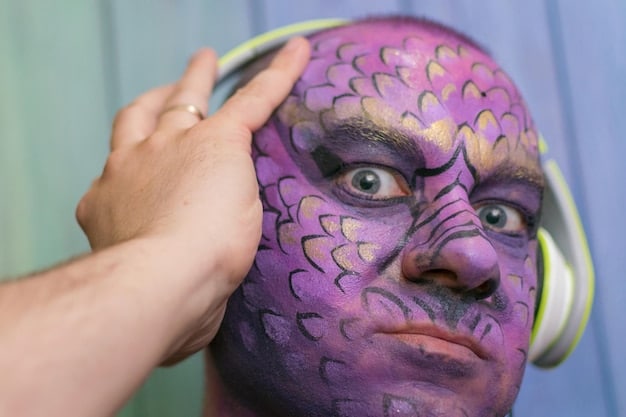
Crafting the Perfect Cosplay Costume: From Design to Execution
Creating a cosplay costume is a journey that requires planning, skill, and dedication. Whether you’re a seasoned cosplayer or just starting out, understanding the process can help you bring your vision to life. This section will guide you through the steps involved in crafting the perfect cosplay costume.
The process of creating a cosplay costume often begins with choosing a character and sourcing reference images. Once you have a clear understanding of the character’s design, you can start planning your costume, considering factors such as budget, skill level, and time constraints.
Choosing Your Character
The first step in crafting a cosplay costume is selecting a character that resonates with you. Consider your own skills and interests when making your choice. Do you enjoy sewing, prop-making, or makeup artistry? Choose a character that allows you to showcase your strengths and learn new skills.
Sourcing and Gathering Materials
Once you’ve chosen your character, it’s time to gather the necessary materials. This may include fabric, foam, Worbla, paint, and various other crafting supplies. Research the different types of materials available and choose those that are best suited for your project. Don’t be afraid to experiment and try new things.
- Fabric Selection: Choose fabrics that match the character’s attire in terms of texture, color, and drape.
- Prop Creation: Determine the materials needed for props, such as foam, plastic, wood, or 3D-printed parts.
- Accessorizing: Identify accessories like wigs, jewelry, footwear, and other details that complete the costume.
- Budgeting: Set a budget for materials and supplies to avoid overspending.
Crafting a cosplay costume is a rewarding experience that allows you to express your creativity and passion. By following these steps and dedicating time and effort to your project, you can create a stunning costume that will impress at conventions and events. Remember to have fun and enjoy the process of bringing your favorite character to life.
Mastering Cosplay Makeup: Techniques and Tips for Transformation
Makeup plays a crucial role in cosplay, transforming you into the character you’re portraying. It’s not just about applying cosmetics; it’s about understanding facial anatomy, color theory, and character design. This section will explore essential makeup techniques and tips to help you master cosplay makeup.
Cosplay makeup can range from simple enhancements to elaborate transformations, depending on the character you’re portraying. The goal is to capture the character’s likeness and convey their personality through makeup. Cosplay makeup often includes contouring, highlighting, and color correction to create a specific look.
Essential Makeup Techniques
Several makeup techniques are essential for cosplay. Contouring and highlighting help define your facial features and create depth. Color correction can neutralize unwanted tones and even out your complexion. Eye makeup, including eyeliner, eyeshadow, and mascara, can dramatically alter your appearance.
Choosing the Right Products
Selecting the right makeup products is crucial for achieving a flawless cosplay look. Look for high-quality products that are long-lasting and suitable for your skin type. Invest in a good primer to create a smooth base and prevent your makeup from creasing or fading. Don’t be afraid to experiment with different brands and formulas to find what works best for you.
- Foundation and Concealer: Choose a foundation and concealer that match your skin tone and provide adequate coverage.
- Contouring and Highlighting: Use contouring and highlighting products to sculpt your face and enhance your features.
- Eyeshadow: Select eyeshadow colors that complement your character’s design and create the desired effect.
- Lipstick: Choose a lipstick color that matches the character’s lips and complements your overall look.
Mastering cosplay makeup takes time and practice, but with the right techniques and products, you can transform yourself into any character you desire. Remember to have fun and experiment with different looks until you find what works best for you. With dedication and creativity, you can achieve stunning results that will impress at conventions and events.
Prop-Making in Cosplay: Bringing Weapons, Accessories, and Gadgets to Life
Props are essential elements in cosplay, adding authenticity and visual appeal to your costume. Whether it’s a sword, a staff, or a futuristic gadget, props help bring your character to life. This section will guide you through the basics of prop-making for cosplay.
Prop-making in cosplay involves creating realistic replicas of weapons, accessories, and gadgets used by characters. These props can be made from various materials, including foam, wood, plastic, and 3D-printed parts. The goal is to create props that are lightweight, durable, and visually accurate.
Choosing Your Materials
The choice of materials for your props depends on several factors, including budget, skill level, and desired level of detail. Foam is a popular choice for beginners due to its affordability and ease of use. Wood is a good option for stronger, more durable props. Plastic and 3D-printed parts are ideal for intricate designs and futuristic gadgets.
Basic Prop-Making Techniques
Several techniques are commonly used in prop-making, including cutting, shaping, sanding, and painting. Foam can be cut with a craft knife or hot wire cutter and shaped with a heat gun. Wood can be cut with a saw and shaped with a sanding block. Plastic and 3D-printed parts can be assembled with glue and screws.
- Foam Crafting: Learn techniques for cutting, shaping, and sealing foam to create lightweight and detailed props.
- 3D Printing: Explore the possibilities of 3D printing for complex and intricate prop designs.
- Painting and Finishing: Achieve realistic textures and effects with proper painting, weathering, and detailing techniques.
- Safety Measures: Always prioritize safety when using power tools and handling materials like adhesives and paints.
Prop-making is a challenging but rewarding aspect of cosplay. By mastering the basic techniques and experimenting with different materials, you can create stunning props that will enhance your cosplay and impress at conventions and events. Remember to prioritize safety and take your time to achieve the best possible results.
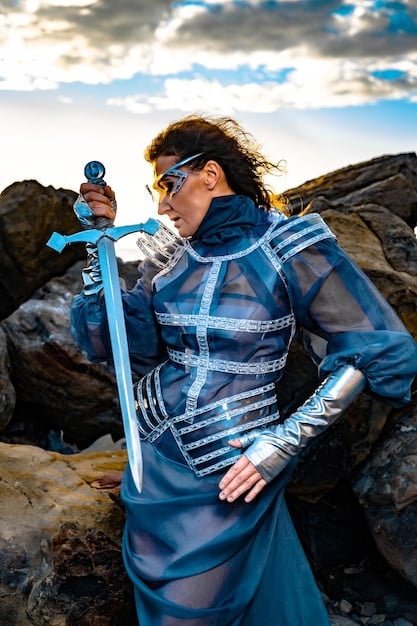
Cosplay Etiquette: Navigating Conventions and Respecting the Community
Cosplay conventions are vibrant and exciting events where cosplayers showcase their creations and connect with fellow fans. To ensure a positive experience for everyone, it’s essential to understand and practice proper cosplay etiquette. This section will outline key guidelines for navigating conventions and respecting the community.
Cosplay etiquette encompasses a set of unwritten rules and best practices that promote a safe, inclusive, and enjoyable environment for all participants. It’s about respecting boundaries, being mindful of others, and contributing to the positive atmosphere of the cosplay community.
Respecting Personal Space
One of the most important aspects of cosplay etiquette is respecting personal space. Always ask for permission before taking photos of cosplayers. Be mindful of your surroundings and avoid blocking pathways or disrupting events. If you accidentally bump into someone, apologize and move on.
Handling Props Safely
If you’re carrying props, be extra cautious to avoid injuring yourself or others. Keep your props under control and be aware of their size and weight. Avoid swinging or brandishing props in crowded areas. If your prop is particularly large or unwieldy, consider disassembling it or storing it in a safe place when not in use.
- Photography Requests: Always ask for permission before taking photos of cosplayers and respect their wishes if they decline.
- Prop Awareness: Be mindful of your surroundings and ensure your props don’t pose a safety hazard to yourself or others.
- Costume Care: Handle your costume with care to avoid damage and be considerate of the effort and craftsmanship involved.
- Respectful Interactions: Engage with other cosplayers and attendees in a friendly and respectful manner, celebrating the shared passion for cosplay.
By practicing good cosplay etiquette, you can help create a positive and inclusive environment at conventions and events. Remember to be respectful, mindful, and considerate of others. Together, we can ensure that cosplay remains a fun and enjoyable hobby for everyone.
Cosplay Photography: Capturing the Perfect Shot
Cosplay photography is an art form that combines cosplay and photography to create stunning images that capture the essence of the characters being portrayed. Whether you’re a cosplayer or a photographer, understanding the basics of cosplay photography can help you create memorable and impactful images. This section will explore essential tips and techniques for capturing the perfect shot.
The goal of cosplay photography is to showcase the cosplayer’s costume, pose, and character portrayal in a visually appealing way. This involves considering factors such as lighting, composition, and background. Cosplay photography can take place in various settings, including conventions, studios, and outdoor locations.
Choosing the Right Location
The location for your cosplay photoshoot can significantly impact the final result. Consider the character’s background and choose a location that complements their personality and story. Natural settings, such as forests, beaches, and parks, can provide beautiful backdrops. Urban environments, such as city streets and abandoned buildings, can add a gritty, realistic touch.
Mastering Lighting Techniques
Lighting is crucial in cosplay photography. Natural light can be beautiful, but it’s often unpredictable. Artificial lighting, such as strobes and reflectors, can provide more control and consistency. Experiment with different lighting setups to find what works best for your subject and location.
- Posing Techniques: Learn how to guide cosplayers in striking dynamic and character-appropriate poses.
- Location Scouting: Seek out visually appealing locations that complement the costumes and characters being portrayed.
- Editing and Post-Processing: Enhance cosplay photos with editing software to adjust colors, contrast, and details.
Cosplay photography is a collaborative art form that requires communication and creativity. By mastering the basic techniques and working closely with cosplayers, you can create stunning images that celebrate their artistry and passion. Remember to have fun and experiment with different approaches to find your unique style.
| Key Aspect | Brief Description |
|---|---|
| 🎭 Definition | Cosplay is embodying characters through costumes and performance. |
| 🧵 Costume Crafting | Creating costumes involves planning, skill, and materials sourcing. |
| 💄 Makeup | Makeup transforms cosplayers into characters using techniques like contouring and highlighting. |
| 📸 Photography | Cosplay photography captures characters in visually stunning ways through careful posing and lighting. |
FAQ
▼
Cosplay originated in the United States at science fiction conventions in the early 20th century, gaining popularity in Japan in the 1970s with anime and manga culture.
▼
Common materials include fabric, foam, Worbla, plastic, and 3D-printed parts, depending on the costume’s design and the cosplayer’s skills.
▼
Makeup is very important in cosplay, as it helps transform the cosplayer into the character by enhancing features and conveying personality.
▼
Cosplay etiquette involves respecting personal space, handling props safely, and being considerate to create a positive environment at conventions.
▼
To improve cosplay photography, focus on choosing the right location, mastering lighting techniques, and guiding cosplayers with effective poses.
Conclusion
Cosplay offers a unique blend of creativity, craftsmanship, and community. Whether you’re a seasoned cosplayer or just starting out, the world of cosplay provides endless opportunities for self-expression, skill development, and connection with like-minded individuals. Embrace the art of transformation and unleash your inner hero.
